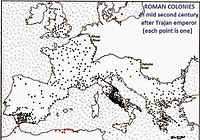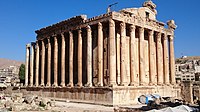Laodicea in Syria
This article may be in need of reorganization to comply with Wikipedia's layout guidelines. (May 2021) |
35°31′08″N 35°46′36″E / 35.51892275°N 35.7766297°E

Laodicea (
History


The
The Roman
, that greatly improved the commerce through the port of Laodicea.There are few remains of what was a rich and well-built town (Strab. 16.2.9): colonnades, a monumental arch, sarcophagi, all within the modern town. The sanctuaries, public baths, amphitheater, hippodrome, mentioned by ancient authors or by Greek inscriptions, and the rampart gates depicted on coins, have all disappeared...The town occupies a rocky promontory...Including the port, its area was ca. 220 ha...A wide avenue, bordered with porticos in Roman times, ran N-S across the town, from the tip of the peninsula to the gate where the road to Antioch started; perpendicular to this, three colonnaded streets ran from E to W. The one to the N was centered on the entry to the citadel on the high hill to the NE. The central one came from the E gate, where the Apamea road reached the city. The street today is occupied by the great souk, where there is still an alignment of 13 monolithic granite columns. A tetrapylon marked the crossing of this thoroughfare with the N-S avenue. The S street began at the port and ended to the E at the long steep hill to the SE, where a monumental four-way arch, erroneously called a tetrapylon, closed off the view. This arch consists of four semicircular arches, one on each side, supporting a stone cupola. Columns engaged in pilasters serve as buttresses at the corners of the four masonry moles. Not far away, inside a mosque, is the corner of a Corinthian peristyle, with capitals and entablature. Virtually nothing remains of the theater, which was built against the SE hill and whose cavea had a diameter of ca. 100 m. Princeton: Laodicea ad mare
The city enjoyed a huge economic prosperity thanks to the wine produced in the hills around the port and exported to all the empire. The city was famous because of the textile products.[citation needed] Laodicea minted coins from an early Roman date, but the most famous are from Severian times.[2]

A sizable
Christianity was the main religion in the city after
An earthquake damaged the city in 494 AD[4] and successively Justinian I made Laodicea the capital of the Byzantine province of "Theodorias" in the early sixth century. Laodicea remained its capital for more than a century until the Arab conquest.
Bishops of Laodicea
- Lucius of Cyrene (1st century), mentioned in Acts, traditionally considered the first bishop
- Thelymidres (fl. 250–251), bishop during the Decian persecution[5]
- Heliodorus, became bishop during the reign of Trebonianus Gallus (251–253)[5]
- Socrates (died. c. 264)[5]
- Eusebius (died c. 268), a native of Alexandria in Egypt[5]
- Anatolius (c. 268 – 282/283), a native of Alexandria in Egypt[5]
- Stephen, apostasized during the Diocletianic persecution (303–313)[5]
- Theodotus (303/313 – c. 335), an Arian[5]
- George (died 359), an Arian[5]
- After George there were two rival bishops in Laodicea:
- Elpidius, bishop by 394, deposed in 404, restored in 416[5]
- Macarius (429-451)
- Maximus (around 458)
- Nicia
- Costantinus (510–518)
- Stephanus (553)
Notes
- ISBN 9780857714893. Retrieved 11 June 2016 – via Google Books.
- ^ "Featured Coin". Retrieved 11 June 2016.
- ^ "LAODICEA - JewishEncyclopedia.com". Retrieved 11 June 2016.
- ISBN 9781884964039
- ^ ].
Bibliography
- Butcher, Kevin. Roman Syria and the Near East Getty Publications. Los Angeles, 2003 ISBN 0892367156 ([1])
- Ross Burns. Monuments of Syria: A Guide. Publisher I.B.Tauris. New York, 2009 ISBN 0857714899


